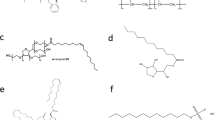Abstract
Purpose. The impact of drug incorporation on melt-homogenized tripalmitin nanoparticles is investigated with ubidecarenone as a model drug. The dispersions are studied with respect to their drug loading capacity, localization and physical state of the drug as well as to potential changes of the nanoparticle properties due to interactions between drug and triglyceride matrix.
Methods. The investigations were carried out using photon correlation spectroscopy, differential scanning calorimetry, synchrotron radiation X-ray diffraction, ultracentrifugation, and cryo- and freeze-fracture transmission electron microscopy.
Results. Ubidecarenone can be incorporated into the dispersions in concentrations higher than 50% of the dispersed phase. The drug is associated with the nanoparticles such that small drug amounts are bound tightly to the carrier matrix while excess drug adheres as a liquid phase to the crystalline particles. Drug incorporation lowers the crystallization and melting temperature of the particle matrix and accelerates the transition of the triglyceride into the stable β-polymorph after crystallization.
Conclusions. Drug incorporation may significantly alter important physicochemical parameters of solid lipid nanoparticles. Slow release of ubidecarenone may only be possible for the fraction of drug which is tightly bound to the matrix while the liquid fraction should be rapidly released.
Similar content being viewed by others
REFERENCES
K. Westesen and B. Siekmann. Biodegradable colloidal drug carrier systems based on solid lipids. In S. Benita (ed.), Microencapsulation, Marcel Dekker, New York, 1996 pp. 213-258.
K. Westesen, H. Bunjes, and M. H. J. Koch. Physicochemical characterization of lipid nanoparticles and evaluation of their drug loading capacity and sustained release potential. J. Control. Release 48:223-236 (1997).
K. Westesen, B. Siekmann, and M. H. J. Koch. Investigations on the physical state of lipid nanoparticles by synchrotron radiation X-ray diffraction. Int. J. Pharm. 93:189-199 (1993).
B. Siekmann and K. Westesen. Thermoanalysis of the recrystallization process of melt-homogenized glyceride nanoparticles. Colloids Surfaces B: Biointerfaces 3:159-175 (1994).
H. Bunjes, K. Westesen, and M. H. J. Koch. Crystallization tendency and polymorphic transitions in triglyceride nanoparticles. Int. J. Pharm. 129:159-173 (1996).
C. Schwarz and W. Mehnert. Freeze drying of drug-free and drug-loaded solid lipid nanoparticles (SLN). Int. J. Pharm. 157:171-179 (1997).
A. zur Mühlen, C. Schwarz, and W. Mehnert. Solid lipid nanoparticles (SLN) for controlled drug delivery—Drug release and release mechanism. Eur. J. Pharm. Biopharm. 45:149-155 (1998).
A. zur Mühlen and W. Mehnert. Drug release and release mechanism of prednisolone loaded solid lipid nanoparticles. Pharmazie 53:552-555 (1998).
A. zur Mühlen, E. zur Mühlen, H. Niehus, and W. Mehnert. Atomic force microscopy studies of solid lipid nanoparticles. Pharm. Res. 13:1411-1416 (1996).
J. C. Thomas. The determination of log normal particle size distributions by dynamic light scattering. J. Colloid Interface Sci. 117:187-192 (1987).
M. C. Schmidtgen, M. Drechsler, J. Lasch, and R. Schubert. Energy-filtered cryotransmission electron microscopy of liposomes prepared from human stratum corneum lipids. J. Microsc. 191:177-186 (1996).
M. Drechsler and H.-J. Cantow. EELS data acquisition processing and display for the Zeiss CEM 902 based on Lotus 1–2–3: Application examples from a biological system and inorganic transition metal compounds. J. Microsc. 162:61-76 (1991).
B. Siekmann and K. Westesen. Preparation and physicochemical characterization of aqueous dispersions of coenzyme Q10 nanoparticles. Pharm. Res. 12:201-208 (1995).
H. Bunjes, B. Siekmann, and K. Westesen. Emulsions of supercooled melts—A novel drug delivery system. In S. Benita (ed.), Submicron Emulsions in Drug Targeting and Delivery, Harwood Academic Publishers, Switzerland, 1998 pp. 175-204.
H. Bunjes and K. Westesen. Influences of colloidal state on physical properties of solid fats. In N. Garti and K. Sato (eds.) Crystallization Process in Fats and Lipid Systems, Marcel Dekker, New York, in press.
H. Yoshino, M. Kobayashi, and M. Samejima. Influence of the liquid phase coexisting in fatty suppository bases on the polymorphic transition rate. Chem. Pharm. Bull. 30:2941-2950 (1982).
D. Chapman. The polymorphism of glycerides. Chem. Rev. 62:433-456 (1962).
H. Bunjes, M. H. J. Koch, and K. Westesen. Effect of particle size on colloidal solid triglycerides. Langmuir 16:5234-5241 (2000).
Author information
Authors and Affiliations
Rights and permissions
About this article
Cite this article
Bunjes, H., Drechsler, M., Koch, M.H.J. et al. Incorporation of the Model Drug Ubidecarenone into Solid Lipid Nanoparticles. Pharm Res 18, 287–293 (2001). https://doi.org/10.1023/A:1011042627714
Issue Date:
DOI: https://doi.org/10.1023/A:1011042627714




